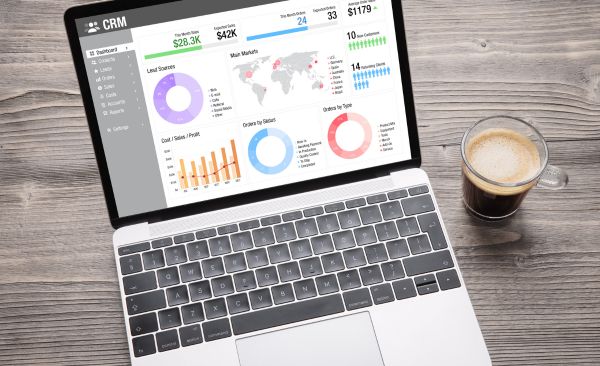In today’s data-driven world, organizations are completely inundated with an abundance of information. To stay ahead of the competition and make informed decisions, it’s crucial to identify and leverage data trends effectively. By harnessing the power of data trends, businesses can uncover valuable insights that drive strategic decision-making. In this blog post, we’ll explore five key methods to identify and leverage data trends for maximizing your organization’s success.
01: Data Collection & Consolidation

The first step in identifying data trends is to ensure you have a robust data collection and consolidation process. Gather relevant data from various sources, such as customer behavior, market trends, and internal performance metrics. By centralizing this data, you create a single source of truth that enables you to perform comprehensive analyses and spot meaningful patterns.
Here are a few examples of this:
Example 1: E-commerce Sales Data
An online retailer wants to identify sales trends to optimize its product offerings. They collect data from their website, mobile app, and third-party marketplaces. By consolidating this data into a centralized database, they can analyze sales figures across different platforms and identify trends in popular product categories, customer preferences, and geographic regions.
Example 2: Manufacturing Process Metrics
A manufacturing company aims to improve its production efficiency. They collect data from various sensors installed in their machinery, tracking metrics like production speed, downtime, and defect rates. Consolidating this data allows them to visualize performance patterns over time, identifying specific operational areas that need improvement and optimizing the overall production process.
Example 3: Customer Feedback and Surveys
A customer support team wants to enhance customer satisfaction. They gather data from customer feedback forms, surveys, and social media interactions. By consolidating this feedback data, they can identify recurring issues, customer preferences, and pain points. This information helps them tailor their support services to meet customer needs effectively.
02: Data Visualization and Analysis

Data trends can often be hidden in a sea of numbers. To make sense of the data and identify patterns easily, invest in data visualization tools. Graphs, charts, and dashboards help present complex information in a visually appealing and understandable manner. Data analysis techniques like regression, clustering, and time-series analysis can help you identify significant trends and relationships within your data.
Let’s look at a few examples:
Example 1: Sales Performance Dashboard
Using historical sales data, a retail chain creates a sales performance dashboard with interactive graphs and charts. This dashboard visualizes sales trends, product popularity, and revenue growth over time. Managers can easily spot patterns and fluctuations, allowing them to adjust inventory levels, run targeted promotions, and optimize pricing strategies accordingly.
Example 2: Market Segmentation Analysis
A marketing team analyzes customer data to segment its audience. They use data visualization techniques to create a pie chart or a bar graph showing the distribution of customers based on demographics, behavior, or purchasing power. This analysis helps them tailor marketing campaigns and offers to specific customer segments, resulting in improved engagement and conversion rates.
Example 3: Website User Behavior Heatmaps
An online media company wants to understand how users interact with their website. They use heatmaps to visualize user behavior, indicating the most and least clicked areas of their web pages. This analysis helps the company identify which content resonates most with their audience, allowing them to optimize their website layout and content placement for better user engagement.
03: Setting Clear Objectives

Before diving into data analysis, establish clear objectives for what you want to achieve. Whether it’s improving customer satisfaction, optimizing production processes, or increasing sales, defining specific goals will direct your data exploration efforts. Having predefined objectives ensures that your data analysis is focused and aligns with the strategic vision of your organization.
Here are a few examples of this:
Example 1: Customer Retention
A subscription-based software company sets a clear objective to improve customer retention. They analyze churn rates and customer satisfaction scores to identify trends and factors leading to customer attrition. Armed with this information, they implement customer success programs and offer tailored incentives, resulting in higher retention rates and increased customer loyalty.
Example 2: Supply Chain Efficiency
A logistics company sets a strategic objective to enhance its supply chain efficiency. They analyze data on transportation times, inventory levels, and delivery routes to identify inefficiencies and bottlenecks. By optimizing their supply chain based on these insights, they reduce lead times, minimize inventory costs, and enhance overall operational efficiency.
Example 3: Market Expansion Opportunities
An established retail brand aims to expand its market presence. They set a clear objective to identify potential locations for new stores. By analyzing demographic data, economic indicators, and competitor locations, they identify underserved markets with high growth potential. This strategic approach ensures that their expansion efforts are well-targeted and yield maximum returns.
04: Adopting Predictive Analytics

While identifying current data trends is essential, predicting future trends can give your organization a competitive edge. Implementing predictive analytics models allows you to forecast potential outcomes and anticipate market changes. By staying ahead of the curve, you can develop proactive strategies that capitalize on emerging opportunities and mitigate risks.
Let me give you a few examples:
Example 1: Sales Forecasting
A consumer electronics manufacturer employs predictive analytics to forecast sales for the upcoming quarter. By analyzing historical sales data, seasonal trends, and macroeconomic indicators, they predict demand patterns for different products and allocate resources accordingly. This allows them to optimize inventory levels, production schedules, and marketing strategies proactively.
Example 2: Customer Lifetime Value (CLV) Prediction
An e-commerce company uses predictive analytics to estimate the future value of individual customers. By analyzing past purchase behavior, browsing habits, and customer demographics, they predict CLV and segment customers based on their long-term potential. This allows the marketing team to prioritize high-value customers, offer personalized recommendations, and optimize retention efforts.
Example 3: Inventory Demand Forecasting
A fashion retailer leverages predictive analytics to forecast inventory demand for each product category. By considering factors such as historical sales data, seasonal trends, and upcoming fashion events, they optimize their purchasing and inventory management. This ensures they have the right products available in the right quantities, reducing stockouts and excess inventory costs.
05: Embracing Machine Learning and AI

Incorporating machine learning and artificial intelligence (AI) technologies can revolutionize your data trend identification process. Machine learning algorithms can process vast amounts of data at unprecedented speeds, uncovering patterns that humans may miss. AI-powered tools can provide real-time insights, enabling you to make agile decisions based on up-to-date information.
Here are a few examples of using machine learning and AI:
Example 1: Fraud Detection
A financial institution implements machine learning algorithms to detect fraudulent transactions in real-time. By analyzing transaction patterns, customer behavior, and geographical data, the system can identify suspicious activities and trigger alerts for further investigation, preventing financial losses and protecting customers’ accounts.
Example 2: Personalized Recommendations
An online streaming service employs AI-powered recommendation systems to provide personalized content suggestions to its users. By analyzing users’ viewing history, preferences, and ratings, the platform recommends movies and TV shows that align with individual tastes. This improves user engagement, retention, and overall user satisfaction.
Example 3: Predictive Maintenance
A manufacturing plant adopts AI-driven predictive maintenance to reduce downtime and maintenance costs. By analyzing sensor data from machinery, the system can detect anomalies and predict potential failures before they occur. This allows the maintenance team to proactively schedule repairs, ensuring optimal machine performance and minimizing production disruptions.
The Wrap-Up

In today’s dynamic business landscape, leveraging data trends for strategic decision-making is no longer optional; it’s a necessity. By implementing a comprehensive data collection and consolidation process, utilizing data visualization and analysis tools, setting clear objectives, adopting predictive analytics, and embracing machine learning and AI, your organization can transform raw data into actionable insights. Empowered with these insights, you can make well-informed decisions that drive growth, efficiency, and innovation. Remember, the key to success lies not just in the data you collect but in how you leverage it to stay ahead of the competition and position your organization for long-term success.
Make that data talk to you!

If you’d like to learn more about a career as a Data Analyst, I would love to invite you to watch my free, on-demand training called “The Making of a Data Analyst” where you’ll learn how to quickly get the skills needed for this very lucrative career. You can register here for a time that works for you!